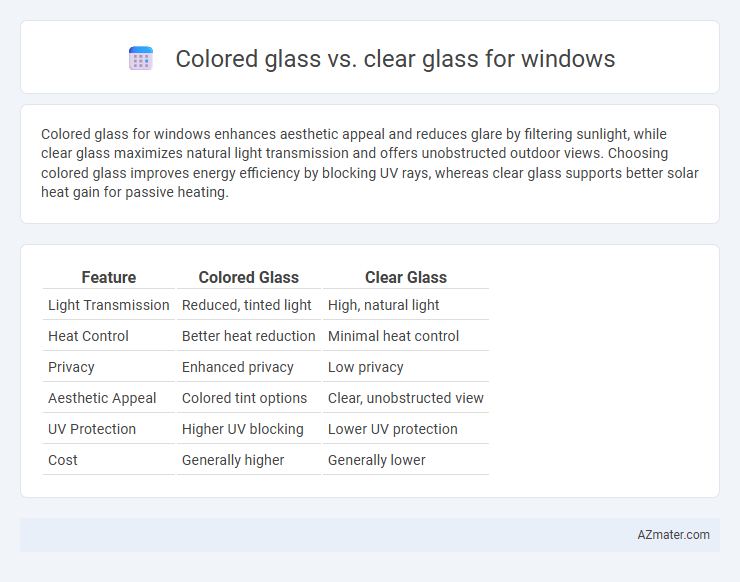Colored glass for windows enhances aesthetic appeal and reduces glare by filtering sunlight, while clear glass maximizes natural light transmission and offers unobstructed outdoor views. Choosing colored glass improves energy efficiency by blocking UV rays, whereas clear glass supports better solar heat gain for passive heating.
Table of Comparison
| Feature | Colored Glass | Clear Glass |
|---|---|---|
| Light Transmission | Reduced, tinted light | High, natural light |
| Heat Control | Better heat reduction | Minimal heat control |
| Privacy | Enhanced privacy | Low privacy |
| Aesthetic Appeal | Colored tint options | Clear, unobstructed view |
| UV Protection | Higher UV blocking | Lower UV protection |
| Cost | Generally higher | Generally lower |
Introduction to Glass Choices for Windows
Colored glass for windows offers enhanced aesthetic appeal and increased privacy by filtering light and adding vibrant hues to interiors. Clear glass maximizes natural light transmission and provides unobstructed outdoor views, making it ideal for spaces requiring brightness and openness. Selecting between colored and clear glass depends on balancing design preferences, light management, and functional needs for window applications.
Aesthetic Appeal: Colored vs. Clear Glass
Colored glass enhances window aesthetics by introducing vibrant hues that create unique visual interest and complement architectural styles, while clear glass offers a timeless, minimalist appeal that maximizes natural light and outdoor views. The choice between colored and clear glass directly influences the atmosphere inside a space, with colored glass adding warmth and character, and clear glass promoting openness and brightness. Both materials provide distinct design opportunities, depending on desired mood and exterior integration.
Light Transmission and Room Ambiance
Colored glass reduces light transmission by filtering specific wavelengths, creating a softer, tinted ambiance in a room that enhances mood and reduces glare. Clear glass allows maximum natural light, maintaining brightness and true color perception, ideal for spaces needing high visibility and openness. Choosing between colored and clear glass impacts both the quality of daylight inside and the overall aesthetic atmosphere of the room.
Energy Efficiency and Thermal Performance
Colored glass windows reduce solar heat gain by filtering specific wavelengths, enhancing energy efficiency in warm climates through decreased cooling costs. Clear glass maximizes natural daylight transmission, supporting passive solar heating and reducing lighting energy use in cooler environments. Selecting between colored and clear glass depends on climate, with colored glass offering superior thermal performance for heat reduction, while clear glass optimizes warmth and light capture.
Privacy Concerns: Which Glass Offers More?
Colored glass provides enhanced privacy by limiting visibility from the outside while still allowing natural light to enter, making it a preferred choice for spaces requiring discretion. Clear glass offers minimal privacy, as it is fully transparent and allows unobstructed views both ways unless combined with treatments like curtains or films. Therefore, colored glass is more effective for privacy concerns in window applications.
UV Protection and Fading Prevention
Colored glass window panes effectively reduce UV radiation penetration, blocking up to 99% of harmful ultraviolet rays, which significantly minimizes interior fading of furniture, fabrics, and artworks. Clear glass, unless treated with specialized UV-protective coatings or films, typically allows higher UV transmission, increasing the risk of color fading and material degradation over time. Selecting colored glass for windows enhances both UV protection and long-term preservation of interior aesthetics by lowering the impact of solar radiation.
Maintenance and Cleaning Differences
Colored glass windows typically require gentler cleaning methods to prevent color fading or surface damage, often needing non-abrasive cleaners and soft cloths to maintain clarity and vibrancy. Clear glass is generally more resilient to aggressive cleaning agents and frequent washing, allowing standard glass cleaners and tools without risking deterioration. Both types demand routine maintenance to prevent buildup of debris and stains, but colored glass's sensitivity necessitates more specialized care to preserve its aesthetic and functional qualities.
Cost Comparison: Colored Glass vs. Clear Glass
Colored glass typically costs 20-30% more than clear glass due to added manufacturing processes and pigmentation materials, making it a premium option for windows. Clear glass remains the most cost-effective choice for standard window installations, offering simplicity and lower production expenses. Bulk orders of clear glass further reduce per-unit costs, while colored glass may have higher maintenance and replacement expenses over time.
Durability and Longevity of Each Glass Type
Colored glass demonstrates enhanced resistance to UV radiation and weathering due to its tinted composition, which helps maintain structural integrity and appearance over time. Clear glass, while offering higher transparency, may be more susceptible to visible wear, such as scratches and discoloration, especially when exposed to harsh environmental conditions. Durability and longevity depend significantly on the glass quality and coating treatments, with colored glass often providing superior performance in exterior window applications.
Best Applications for Colored and Clear Glass in Windows
Colored glass in windows enhances privacy, reduces glare, and adds aesthetic value, making it ideal for decorative applications, residential facades, and commercial buildings seeking unique design elements. Clear glass allows maximum natural light transmission and unobstructed views, best suited for areas requiring daylight, such as office spaces, living rooms, and storefronts. Both types can be combined with coatings or laminates to improve energy efficiency and UV protection based on specific building performance needs.

Infographic: Colored glass vs Clear glass for Window
 azmater.com
azmater.com